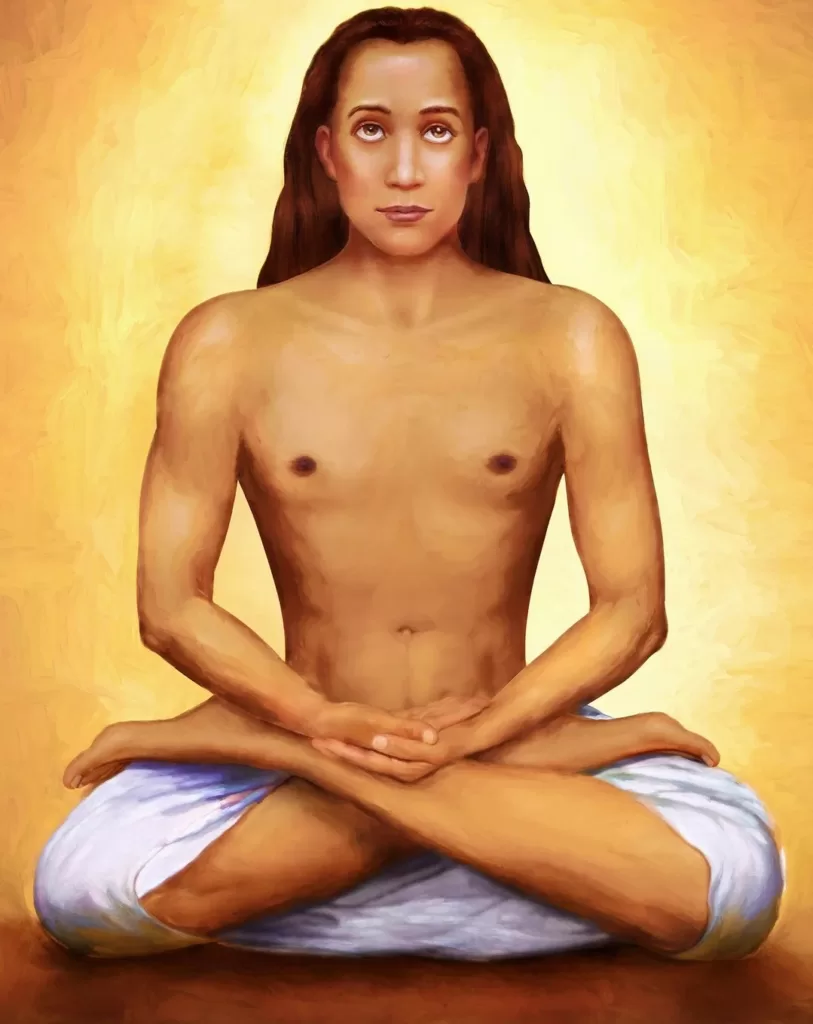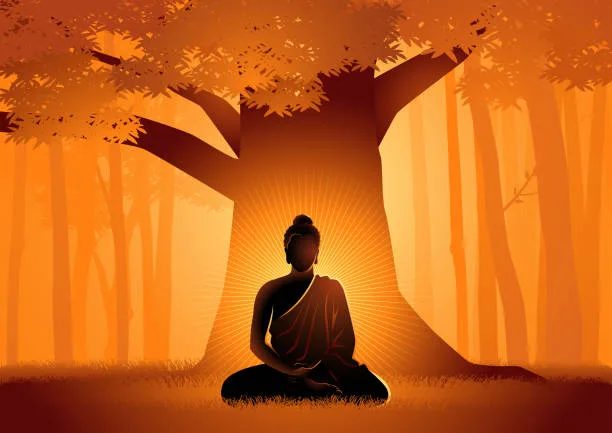The great spiritual personality of all times, Lahiri Mahasaya, also known as Lahiri Baba, was a highly esteemed yogi and spiritual teacher who lived from 1828 to 1895. Lahiri Mahasaya was an Indian yogi master who developed the Kriya Yoga system. He is considered a significant figure in the revival and dissemination of Kriya Yoga, a powerful spiritual practice.
He was rare among the holy people of India in that he was a householder; he married, had children, and worked as an accountant for the government. He was known as the “Ideal Yogi-Householder.” Through Paramahansa Yogananda, a disciple of Sri Yukteswar Giri, and through Yogananda’s book Autobiography of a Yogi, which was published in 1946, he became well-recognized in the Western world. In the year 1861, his non-physical guru Mahavatar Babaji manifested before him and gave him the directive to make the yogic science of Kriya Yoga available to the general public once again after its guardians had kept it secret for decades.

Lahiri Mahasaya was born in a village in Bengal, India. He led an ordinary life as a married householder and worked as an accountant in the British administration. It was during this time that he experienced a profound spiritual awakening and was initiated into the ancient practice of Kriya Yoga by the immortal yogi Mahavatar Babaji, who is said to be thousands of years old.
Lahiri was born into a Brahmin family in the Nadia region of Bengal Province, specifically in the village of Ghurni (now a part of Krishnanagar municipality). Muktakashi, Gaur Mohan Lahiri’s wife, had him as her youngest son. His mother passed away while he was young, and all that is known about her is that she was a Lord Shiva devotee. When he was around three or four years old, he would sit in the sand with his head buried to meditate. After the flood that occurred when Lahiri was five years old, his family relocated to Varanasi, where he would spend the majority of his life.
He began his education with the Vedas and the Urdu and Hindi languages and afterward studied Bengali, Sanskrit, Persian, French, and English at the Government Sanskrit College. It was a regular part of his regimen to recite Vedic mantras, take a dip in the Ganges, and pray.
He tied the knot with Srimati Kashi Moni in 1846. Tincouri and Ducouri were their boys, and Harimoti, Harikamini, and Harimohini were their daughters. The two boys he had were revered as saints. Guru Ma is how Lahiri affectionately referred to his wife after she became one of his students. As an accountant for the Indian government’s Military Engineering Department, his duties carried him all throughout the country. The family in Varanasi relied on him after his father passed away to provide for them.
Lahiri Mahasaya – The Kriya Yoga Master
Lahiri was moved to Ranikhet, at the base of the Himalayas, in 1861. While exploring the Dunagiri hills one day, he became aware of a voice calling out to him. Once he reached a higher altitude, he was able to meet his Guru, Mahavatar Babaji, who taught him Kriya Yoga. Babaji instructed Lahiri to devote the remainder of his life to teaching others about Kriya.

Soon after, Lahiri Mahasaya moved back to Varanasi and began introducing Kriya Yoga to earnest students. As time went on, more and more individuals came to learn Kriya from Lahiri. His devotees gave him the Sanskrit spiritual term Mahasaya, which means “large-minded,” to reflect his lofty spiritual status. His devotees also referred to him as Yogiraj and Kashi Baba. At his “Gita Assemblies,” where he gathered people together for study, he regularly delivered lectures on the Bhagavad Gita. At a time when caste discrimination was at its worst, he freely initiated people of all faiths into Kriya, not just Hindus, Muslims, and Christians. He taught the Kriya techniques alongside the pupils’ existing religious practices, encouraging them to remain true to their own beliefs.
He worked as an accountant, providing for his family, and as a Kriya Yoga instructor until he was able to retire on a pension in 1886. There was a surge in the number of people wanting to see him now. He was easily accessible to everyone who wanted his darshan, although he rarely left his sitting room. Breathless samadhi, a state of superconsciousness, was a common occurrence for him.
After receiving initiation from Babaji, Lahiri Mahasaya dedicated his life to the practice and dissemination of Kriya Yoga. Kriya Yoga is a comprehensive system that involves specific breathing techniques, meditation, and spiritual principles aimed at attaining direct realization of the divine within oneself. It is often referred to as the “yoga of action” or the “scientific technique of God-realization.”
Lahiri Mahasaya’s teaching and practice of Kriya Yoga emphasized the integration of spiritual realization with everyday life. He emphasized that one can experience divine consciousness while fulfilling worldly responsibilities. Lahiri Mahasaya advocated the universality of Kriya Yoga, stating that it is accessible to all sincere seekers, regardless of their religious or cultural background.
The master’s impact on Kriya Yoga was significant, primarily due to his disciples, who carried his teachings forward. His foremost disciple, Swami Sri Yukteswar Giri, became a renowned spiritual teacher and guru of Paramahansa Yogananda, who is credited with introducing Kriya Yoga to the West through his book “Autobiography of a Yogi.” Yogananda’s efforts to spread Kriya Yoga have made it more widely known and practiced worldwide.
Lahiri Mahasaya’s teachings and the practice of Kriya Yoga offer profound benefits to practitioners. It is believed that Kriya Yoga accelerates spiritual growth, leading to self-realization, inner peace, and a deep connection with the divine. The practice aims to harmonize body, mind, and soul, purify one’s consciousness, and awaken the dormant spiritual energy, known as Kundalini, within oneself.
Various lineages and organizations all over the world continue to teach and practice Kriya Yoga today. It is regarded as a profound spiritual path that enables seekers to experience direct communion with their higher selves and the divine. The teachings of Lahiri Mahasaya and the practice of Kriya Yoga have had a transformative impact on countless individuals, offering a path to spiritual awakening and self-realization.
Importance of chakras in Kriya yoga
In Kriya Yoga philosophy, the chakras are considered vital energy centers within the human body. Activating and balancing these chakras is believed to be crucial for attaining self-realization or spiritual awakening. Lahiri Mahasaya emphasized the importance of working with the chakras as a means to achieve higher states of consciousness and union with the divine.
Here are some key points regarding the significance of activating the chakras, according to Lahiri Mahasaya:
- Energy centers: The chakras are seen as interconnected energy centers aligned along the spine. Each chakra is associated with specific qualities, functions, and aspects of human experience.
- Prana and Kundalini: Prana refers to the vital life force energy that flows through the chakras and the entire body. Kundalini is the dormant spiritual energy believed to reside at the base of the spine. Through the practice of Kriya Yoga, one seeks to awaken and raise the Kundalini energy, leading to spiritual evolution.
- Balance and purification: Activating the chakras involves clearing any blockages or imbalances in their respective energy flow. This process requires dedicated spiritual practice, including breath control, meditation, and specific techniques taught in Kriya Yoga.
- Consciousness expansion: As the chakras become purified and balanced, the practitioner may experience heightened states of awareness and expanded consciousness. This can lead to profound insights, self-realization, and a deeper connection with the divine.
- Integration and transformation: Working with the chakras helps in integrating various aspects of one’s being, including the physical, mental, emotional, and spiritual dimensions. It facilitates personal growth, healing, and transformation on multiple levels.
It’s important to note that the understanding and practice of chakra activation vary across different spiritual traditions. Lahiri Mahasaya’s teachings on the chakras and their role in self-realization are specific to Kriya Yoga. As with any spiritual practice, individual experiences may vary, and seeking guidance from qualified teachers is advisable for those interested in exploring these concepts further.
Is it necessary to renounce the world to attain self-realization
Lahiri Mahasaya emphasized that Kriya Yoga can be practiced by householders, meaning individuals who lead a life engaged in worldly activities such as work, family, and social responsibilities. He believed that it was not necessary to renounce or withdraw from one’s worldly duties in order to pursue spiritual practices.
Lahiri Mahasaya himself was a married householder and worked as an accountant. He demonstrated through his own life that it is possible to maintain a spiritual practice while fulfilling one’s worldly responsibilities.
According to Lahiri Mahasaya, the practice of Kriya Yoga is adaptable to the needs and circumstances of individuals from all walks of life. It involves integrating spiritual awareness into everyday activities and finding a balance between worldly duties and inner growth.
Lahiri Mahasaya believed that by incorporating Kriya Yoga techniques into daily life, householders could gradually attain spiritual progress, inner transformation, and self-realization.
However, it’s important to note that Lahiri Mahasaya’s teachings were specific to Kriya Yoga and his approach to spirituality. Other spiritual paths may have different perspectives on the role of householders and renunciation. As always, it is advisable to seek guidance from qualified teachers or practitioners who can provide specific guidance based on your individual circumstances and spiritual aspirations.
Purana Purusha Yogiraj Sri Shama Churn Lahiree
Lahiri Mahasaya did not publish any autobiographies. Lahiri Mahasaya did not leave any written writings behind. He never believed in any form of publicity and even forbade the taking of photographs. He emphasized that as soon as a photograph is available to the general public, people will begin to worship the image and neglect sadhana. His intention was for people to practice kriya yoga while maintaining domestic duties and supporting a family. His teachings and spiritual practices were instead transmitted through his disciples and adherents.
Yogiraj Publications released Purana Purusha Yogiraj Sri Shama Churn Lahiree, A Complete Biography in 2011, and it was available in its sixth edition. Examine the eight other books that were published by Yogiraj Publi and Ashoke Kumar Chatterjee, who is also the book’s title character. raster. Available on Amazon and other e-commerce websites, the Purana Purusha Yogiraj Sri Shama Churn Lahiree: A Complete Biography book is currently in its sixth edition.
The book paints a detailed picture of how to achieve self-realization, or god-realization, which is the ultimate aim that everyone should work towards, and how to put an end to the cycle of being born, living, and dying. After coming to the understanding that one is god, the ultimate objective is to achieve Samadhi and then move into the void, or nothingness. This is what it means to open the third eye and achieve superconsciousness in spiritual parlance. continually contemplates God, who is responsible for all of that person’s actions. No matter how far away I am, if you have genuine trust in me, there is no other option for me to assist you besides making myself available in the here and now.

The book depicts that it is unnecessary for you to request benevolence from the master. You and your complete family circle will be the responsibility of the Master if his instructions are carried out to the letter. Nobody can offer as much as the Master does for his disciples or devotees. No one else even comes close. It is not possible for a stranger’s reflection in a mirror to ever make a person feel better about themselves. The only thing that is limited in size is the human intellect. If you consider my picture to be nothing more than a picture, then it will appear as such to you; however, if you consider it to be a safety belt, then it will appear as such to you.
If You have enjoyed reading this article please write your views in the comment section below.
Disclaimer: The author’s views are his or her own. The facts and opinions in the article have been taken from various articles and commentaries available in the online media and Eastside Writers does not take any responsibility or obligation for them.
Note: Contact our Writers at www.eastsidewriters.com for writing Blogs/Articles on any niche. We have experts in various domains from Technology to Finance and from Spirituality to Lifestyle and Entertainment.







Pingback: You Are Your Own God, For You Can Do Wonders That You Believe Only God Can Do! - Eastside Writers
Pingback: The Gateway To Super-Consciousness: The Profound Spiritual Significance Of The Medulla Oblongata - Eastside Writers
Pingback: Develop mental calmness like a monk and enjoy a serene and blissful existence! - Eastside Writers
Pingback: The Divine Bow: Unveiling the Mystical Significance and Philosophical Depths of Namaste - India's Ancient Art of Salutation - Eastside Writers
Pingback: Unveiling the Enigmatic Power of the Pineal Gland: A Spiritual Awakening Journey into the Supernatural - Eastside Writers
Pingback: Exploring the Pursuit of Moksha and Samadhi in Life: Balancing Enjoyment and Spiritual Liberation - Eastside Writers
Pingback: Embracing The Power Of Shoonya Chitta For Eternal Bliss And Holistic Development of the Mind - Eastside Writers
Pingback: From Ordinary to Truly Extraordinary: A Guide to Living Life to the Fullest - Eastside Writers
Pingback: How to Reduce Your Karmic Bondage Through Kriya Yoga: A Path Toward Moksha - Eastside Writers